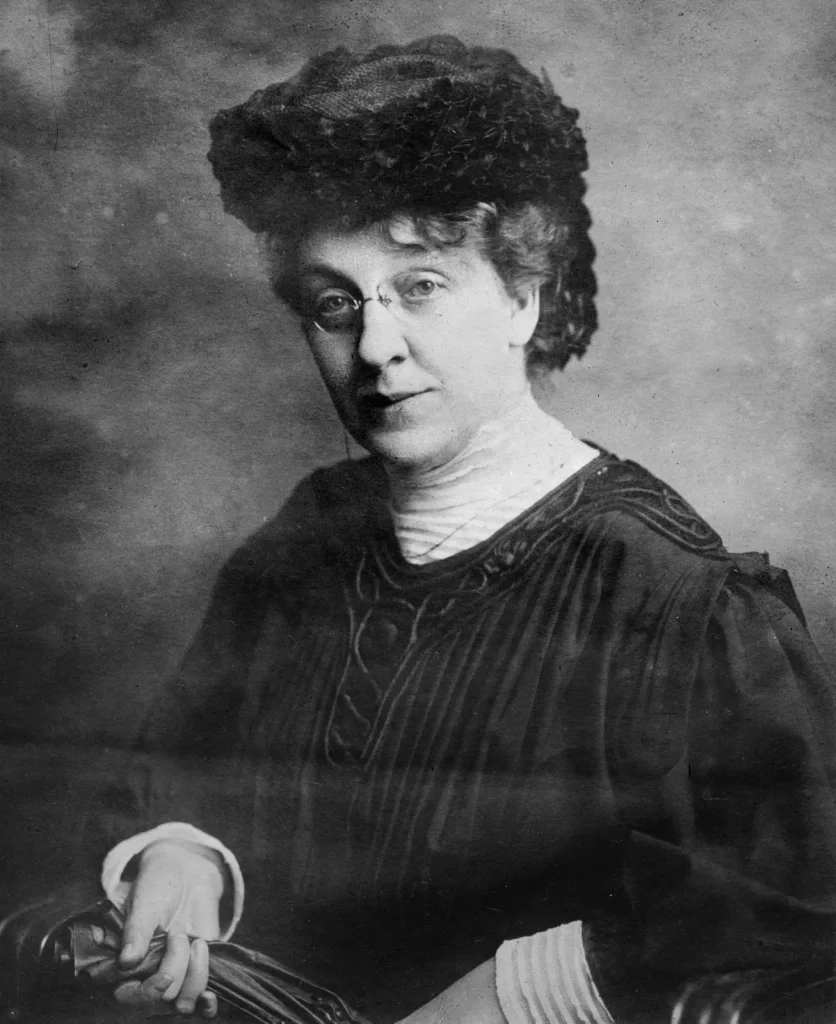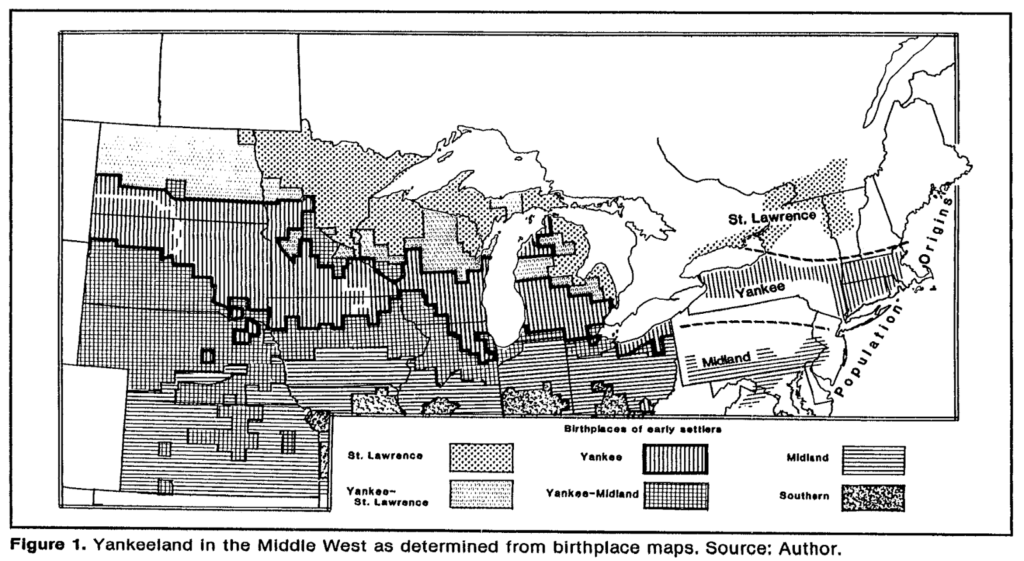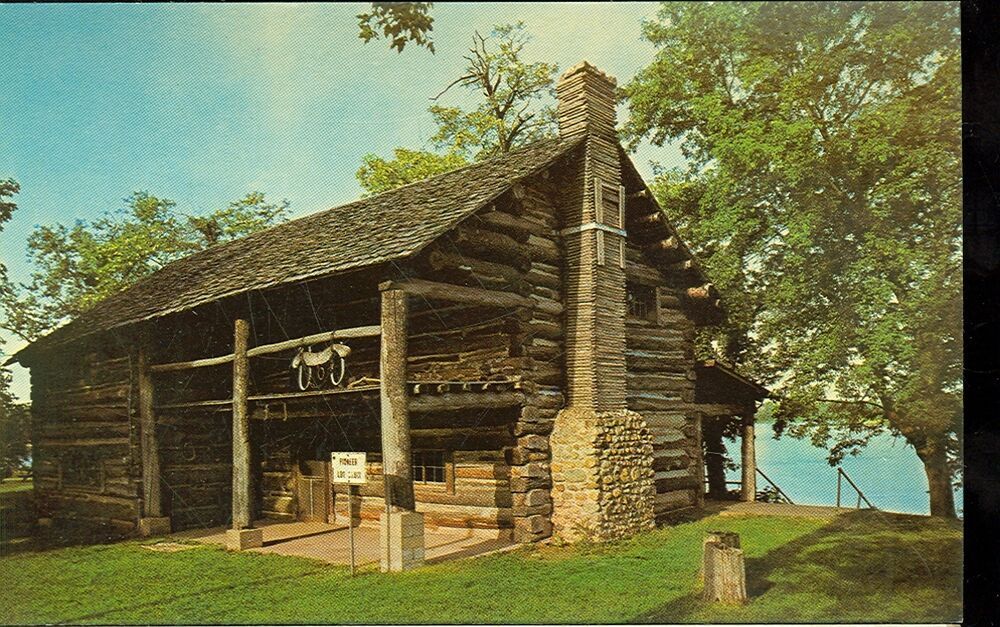Michigan’s Yankees
Brian C. Wilson
Yankees in Michigan
East Lansing: Michigan State University Press, 2008
If you have the chance, visit the Detroit Institute of Arts Museum. The Museum’s collection is brilliant, and contains some of the best art from around the world, including works from ancient Mesopotamia, Egypt, and Greece. This drives home the fact that no French or Italian art collector has scoured England, Australia, or Michigan for magnificent art.
The Detroit collection is the result of Michigan’s enormous wealth resulting from the state’s historical industrial output. It is a form of artistic creativity applied to industry and commerce, and is a byproduct of Michigan’s dominant culture. This culture comes from the Yankee settlers of New England and the Yankee-Yorker settlers from Upstate New York whose parents or grandparents were from New England. These Yankees and Yankee-Yorkers migrated to Michigan in large numbers in the early nineteenth century, and many American whites have at least some Yankee ancestry.

New Englanders migrated westwards from Massachusetts. They were greatly aided by the Erie Canal, which lowered transportation costs tremendously.
Puritan origins
Brian C. Wilson has written an important study of Michigan’s Yankees. Yankees are the descendants of New England’s Puritan founders who arrived in Plymouth on the Mayflower in 1620 and on the Winthrop Fleet in 1630. Most of the Puritans originated in East Anglia, with a smaller subset coming from the West Country, excluding Cornwall. Very few immigrants arrived in New England after 1660, and the region’s expansive growth thereafter was entirely due to natural births.

The Puritans of New England applied their intense religious faith to their vocation. This fervor made them inventive and wealthy.
The Puritans wished to purify the Church of England of all Catholic influences. They were also Calvinists. As such, they believed that humanity is doomed to be separated from God apart from an elect few who are to be saved via the Covenant of Grace. In Calvinist theology there is no religious ritual an individual can do to prove he is among the elect, but there can be signs of divine grace in the form of wealth and long life. New England’s Puritans therefore worked very hard at their vocations, saving money and practicing self-discipline.
Puritans transitioned into Yankees after King Philp’s War. In 1690, due in no small part to that conflict’s extensive costs in blood and treasure,
. . . representatives of the English King wrested political power from the oligarchs, disrupting the Puritans’ theocratic government and imposing a limited religious freedom for non-Puritans. Anglicans, Baptists, and Quakers all began to complete for members with the old Puritan churches, now called Congregationalist churches. Furthermore, increased royal control bound the New England colonies closer to the Mother Country, exposing New Englanders to cultural, political, and economic forces that would fundamentally change their society. Enlightenment rationalism challenged elements of Puritan theology, radical republican ideas began to filter across the Atlantic, and the influence of a global market economy came to be strongly felt, Boston and the other seaport towns became more cosmopolitan, while the interior towns became wealthier and more refined. In short, New England became more modern and, subsequently, more secular, and individualistic. The cumulative effect of modernization on the people of New England was a gradual transition from “Puritan” to “Yankee.” (13)
The United States government opened Michigan to white settlers in 1818, but for a time reaching the area was difficult due to Ohio’s Black Swamp, which made overland travel difficult. Although steamships were available on Lake Erie, and the cost of passage across the Lake was a mere $3. After the Erie Canal was completed in 1825, the cost to reach Michigan from Massachusetts was $10, and freight rates were so low that families could cheaply transport all their belongings. Travel time from Vermont to Michigan’s interior along the Canal likewise fell from 32 days to three weeks.
Many of New England’s clergy and other leaders encouraged Yankees from unproductive farms on Vermont’s hills and elsewhere to migrate west out of a desire for ethnic expansion. Preachers such as Lyman Beecher encouraged New Englanders to procreate and move west both to win the land and to keep Southerners and Catholic Québécois from taking the area.
When compared to ethnic tensions in Europe, the ethnic conflicts between the Yankees, Québécois, and Southerners was negligible, but the Yankees nonetheless viewed the Anglo-Southerners as their main rival in America, as they saw them as indolent — even though they still appreciated that they were fellow ethnic Englishmen. The Southerners had arrived in Michigan before the Yankees, but only in the extreme southwestern part of the state and in very small numbers via Indiana. Their ancestors were a mix of Virginians and Scots-Irish from Appalachia. Many of these Southerners had intermarried with the Yankees by the 1850s.
Michigan’s pioneer farmers drained the wetlands and cleared the forests. Hunger stalked them, and it was only after their farms were fully developed and their food sources secured that people looked back upon the destruction of so much of the region’s natural habitat with any philosophical wistfulness.
Michigan’s Yankees didn’t see the land that they were clearing and developing as a sacred farmstead to be passed down to their descendants for all eternity. They saw it as a commodity like any other, and if the opportunity arose, they would sell their farms and move to the developing towns, or use them to save for retirement. They preferred to farm as close to the towns as possible. Control over the urban areas likewise increased the Yankee and Yankee-Yorker control of Michigan’s overall culture.
Michigan Yankee culture & metapolitics
Michigan’s Yankees could claim descent from East Anglia’s Puritans. They were also influenced by the two Great Awakenings. The first took place in New England in the 1730s and ‘40s:
. . . this series of revivals has long been interpreted by scholars as a collective attempt to turn back the clock and return New England to the more God-focused society of the original Puritan settlers. While impossible, of course, the Awakening did lead to the rise of aggressive moralism among Yankees. (15)

You can buy Julie Howard-Hobson’s I do not belong to the Baader-Meinhof Group, here.
The Second Great Awakening occurred in Upstate New York, where many Yankees had settled after independence. This area came to be called the Burned Over District, since the fires of religious revival swept to and fro across the region. Michigan was being developed during this Awakening and its settlers had enormous religious zeal.
Michigan’s Yankees adhered to a variety of mostly Protestant religious denominations split along class lines. Big Yankees, who were economically successful, tended to be Congregationalists, Episcopalians, and Presbyterians. Little Yankees were often Baptists or Methodists. There were also more colorful denominations such as the Strangite Mormons and Seventh-day Adventists. The Strangite Mormon community departed Michigan, however, after its leader was assassinated by disgruntled members. The Seventh-day Adventists continue to thrive there, however, and their descendants went on to develop health foods such as breakfast cereal.
Michigan’s Yankees prior to the Civil War were interested in three social reforms: the abolition of slavery, temperance, and observance of the Sabbath. In Yankee-established Vermontville, a “loud smile” on Sunday was not tolerated. The abolitionists hated slavery, but also wanted blacks and whites to be separate. They likewise prevented sub-Saharans from voting.
The Civil War was so catastrophic, however, that Michigan’s Yankees eventually abandoned their fixation on sub-Saharan uplift and radical Republican political theories. They instead focused their inventive genius on industry. Ransom Olds was one of the first to combine a steam engine with a carriage to create an early version of the automobile. Other Yankees established the mining industry in the Upper Peninsula, and the timber industry was similarly dominated by Yankee businessmen. Michigan’s lumber trade was run by Yankees who had roots in Maine. One of them, Horace Butters, invented the timber skidding sled, while another, Winfield Garrish, developed the logging railroad.

Unitarian Minister Caroline Bartlett Crane was a mother of two children and developed methods for inspecting processed meat.
Social reforms
Michigan’s Yankees active in social reform. Unitarian Minister Caroline Bartlett Crane served in several churches across the North, including South Dakota. She is most remembered for her work in Michigan, however, where she pioneered the systematic inspection of food, particularly meat and dairy, as well as garbage collection and the construction of sewers. She also worked to improve the quality and availability of basic health care.
Today, liberal Protestant denominations such as the Unitarians are working toward various sub-Saharan uplift schemes and support sexual deviancy. The Yankee social reformers of the Progressive Era were also partly ethnic activists, and many were sympathetic to moving sub-Saharans back to Africa and closing the borders. This shows that social reforms must be focused on a particular people, or else the whole effort goes awry.
The decline of Yankee Michigan
The Michigan Yankees didn’t go extinct, but began to identify as Midwesterners. After the Civil War they intermarried and became politically aligned with other white Protestant groups, especially English-Canadians and immigrants from Northern Europe. By the mid-twentieth century, Protestant Midwesterners such as Gerald L. K. Smith were aligning with American Catholics such as Father Coughlin. Smith even translated his writings into Polish when he lived in Michigan. Michigan’s Yankees also came to view New England differently. New England was more cosmopolitan and far more aligned with finance than Michigan, which came to rely on an industrial economy.
The Michigan Yankees’ industry and work ethic are worth emulating, and their inventiveness was outstanding. But the most important thing they did was to have as many children as possible. These large families in turn produced a society of orderly, inventive, and resourceful people.
* * *
Counter-Currents has extended special privileges to those who donate $120 or more per year.
- First, donor comments will appear immediately instead of waiting in a moderation queue. (People who abuse this privilege will lose it.)
- Second, donors will have immediate access to all Counter-Currents posts. Non-donors will find that one post a day, five posts a week will be behind a “Paywall” and will be available to the general public after 30 days.
- Third, Paywall members have the ability to edit their comments.
- Fourth, Paywall members can “commission” a yearly article from Counter-Currents. Just send a question that you’d like to have discussed to [email protected]. (Obviously, the topics must be suitable to Counter-Currents and its broader project, as well as the interests and expertise of our writers.)
To get full access to all content behind the paywall, sign up here:
Paywall Gift Subscriptions
 If you are already behind the paywall and want to share the benefits, Counter-Currents also offers paywall gift subscriptions. We need just five things from you:
If you are already behind the paywall and want to share the benefits, Counter-Currents also offers paywall gift subscriptions. We need just five things from you:
- your payment
- the recipient’s name
- the recipient’s email address
- your name
- your email address
To register, just fill out this form and we will walk you through the payment and registration process. There are a number of different payment options.








